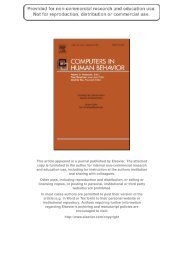Six Models for the Internet + Politics
You also want an ePaper? Increase the reach of your titles
YUMPU automatically turns print PDFs into web optimized ePapers that Google loves.
Archon Fung, Hollie Russon Gilman, and Jennifer Shkabatur 41<br />
FIG 6. Constituent Mobilization<br />
which people learned about upcoming protests. Those who received in<strong>for</strong>mation<br />
from social media were also more likely to physically attend <strong>the</strong> protests (Tufekci<br />
and Wilson 2012). A similar dynamic occurred during student protests in Chile,<br />
as <strong>the</strong> use of Facebook was significantly associated with protest activity (Valenzuela,<br />
Arriagada and Scherman 2012). The network effects of plat<strong>for</strong>ms such as<br />
Facebook and Twitter allow a rapid dissemination of political messages and an<br />
effective organizational tool. Indeed, <strong>the</strong>y have become essential tools of<br />
mobilization <strong>for</strong> many political advocacy groups and organizations (Trippi 2004;<br />
Chadwick 2006).<br />
In our fifth model, a central contribution of digital communication in politics<br />
is to thicken <strong>the</strong> connection between political organizations and <strong>the</strong>ir members.<br />
Lowering <strong>the</strong> costs of communications allows political organizations to communicate<br />
more in<strong>for</strong>mation to more members at a fixed cost. Conversely, digitalization<br />
lowers search costs and allows individuals to find <strong>the</strong> organizations that<br />
advance <strong>the</strong>ir interests and perspectives. Finally, digitalization dramatically lowers<br />
<strong>the</strong> transaction costs of some kinds of political action such as donating money to<br />
organizations and signing letters and petitions.<br />
Unlike <strong>the</strong> first three models of <strong>Internet</strong> and politics, this fifth model is compatible<br />
with individual incentives and institutional constraints. Political organizations<br />
such as interest groups and political parties seek to mobilize <strong>the</strong>ir<br />
constituents with or without <strong>the</strong> <strong>Internet</strong> because such mobilization is a key<br />
resource <strong>for</strong> influencing policy makers and winning elections. Digital tools, like<br />
<strong>the</strong>ir precursor direct mail, amplify <strong>the</strong>ir mobilization ef<strong>for</strong>ts. Political organizations<br />
are <strong>the</strong>re<strong>for</strong>e deeply interested in creating <strong>the</strong> best methods <strong>for</strong> digital<br />
mobilization, and <strong>for</strong> improving <strong>the</strong> digital tools to mobilize more people<br />
(Figure 6).<br />
ICT plat<strong>for</strong>ms per<strong>for</strong>m at <strong>the</strong>ir best <strong>for</strong> cases of precise, goal-oriented, and<br />
time-constrained actions, such as political campaigns or protests. The Brazilian<br />
plat<strong>for</strong>m Cidade Democratica 20 is a particularly interesting case. Unlike <strong>the</strong> cases<br />
mentioned above—<strong>the</strong> Dean or Obama Campaigns or MoveOn.org—Cidade<br />
does not advance a particular politician or political cause. Instead, it employs<br />
ICT to create a marketplace <strong>for</strong> mobilization. Cidade Democratica originates<br />
from Sao Paolo, Brazil. It enables citizens, organizations, and governmental institutions<br />
to report problems in <strong>the</strong> city and propose solutions. The plat<strong>for</strong>m covers<br />
a wide range of municipal issues, from environment and health to transport,<br />
education, and planning.<br />
The underlying idea of Cidade Democratica is that citizens can and should<br />
assume responsibility over <strong>the</strong>ir living environment, take an active part in problem<br />
solving, and promote public causes that <strong>the</strong>y care about. The plat<strong>for</strong>m is<br />
<strong>the</strong>re<strong>for</strong>e best understood as a collaborative social network that allows individu-<br />
20 http://www.cidadedemocratica.org.br/.
















